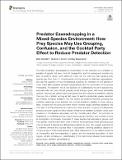Files in this item
Predator eavesdropping in a mixed-species environment : how prey species may use grouping, confusion, and the cocktail party effect to reduce predator detection
Item metadata
| dc.contributor.author | Goodale, Eben | |
| dc.contributor.author | Ruxton, Graeme D. | |
| dc.contributor.author | Beauchamp, Guy | |
| dc.date.accessioned | 2019-05-17T14:30:06Z | |
| dc.date.available | 2019-05-17T14:30:06Z | |
| dc.date.issued | 2019-05-08 | |
| dc.identifier | 258994480 | |
| dc.identifier | bcd9f1d8-f3ac-475d-a3e5-34151bb75e08 | |
| dc.identifier | 85065126119 | |
| dc.identifier | 000467414300001 | |
| dc.identifier.citation | Goodale , E , Ruxton , G D & Beauchamp , G 2019 , ' Predator eavesdropping in a mixed-species environment : how prey species may use grouping, confusion, and the cocktail party effect to reduce predator detection ' , Frontiers in Ecology and Evolution , vol. 7 , 141 . https://doi.org/10.3389/fevo.2019.00141 | en |
| dc.identifier.issn | 2296-701X | |
| dc.identifier.other | ORCID: /0000-0001-8943-6609/work/60427485 | |
| dc.identifier.uri | https://hdl.handle.net/10023/17721 | |
| dc.description | EG is grateful for the support of the Special Talents Recruitment Program of Guangxi University, and National Science Foundation of China grants 31560119 and 31770424. | en |
| dc.description.abstract | The field of predator eavesdropping concentrates on the detection by a predator or parasite of signals that prey direct at conspecifics, and the subsequent evolution by prey to avoid or lessen such detection. Here, we first point out that signaling prey species are often found in mixed-species moving groups or stationary aggregations, and ask the question of how simultaneous signaling, by members of one species or more, might affect predator eavesdropping behavior and the composition of the groups themselves. The detection risk of prey species will be affected by the other species they associate with, and prey should generally avoid joining a group with more detectable species. Yet prey may select to join other species that are preferred by predators, diluting their own risk of attack, as long as that does not lead to substantially greater detection and thereby increased predation. We next review the evidence that prey grouping and collective responses when attacked can confuse predators, leading to lower capture rates. Evidence for this confusion effect mostly involves visually orienting predators. We then ask if a similar phenomenon could occur when animals in a group simultaneously send acoustic signals, and find relevant evidence for predator confusion under such situations in the literature associated with the "cocktail party effect". As confusion is heightened by similarities among mixed-species group members, this provides a force at ecological or evolutionary timescales to make species that associate in groups, and their signals, more similar to each other. However, heterogeneous mixed-species groups may be favored if species are differentially preferred as prey. We suggest experiments to examine whether the success rates of acoustically orienting predators depend on the group size of their mixed-species prey. More observations on the relative positions of conspecifics and heterospecifics in space, and the temporal association of their signals, will also increase our understanding of the relationship between mixed-species grouping and predator eavesdropping. | |
| dc.format.extent | 9 | |
| dc.format.extent | 550216 | |
| dc.language.iso | eng | |
| dc.relation.ispartof | Frontiers in Ecology and Evolution | en |
| dc.subject | Animal sociality | en |
| dc.subject | Cocktail party problem | en |
| dc.subject | Communication networks | en |
| dc.subject | Confusion effect | en |
| dc.subject | Group living | en |
| dc.subject | Mixed-species choruses | en |
| dc.subject | Mixed-species groups | en |
| dc.subject | Predator eavesdropping | en |
| dc.subject | QH301 Biology | en |
| dc.subject | Ecology, Evolution, Behavior and Systematics | en |
| dc.subject | Ecology | en |
| dc.subject | T-NDAS | en |
| dc.subject.lcc | QH301 | en |
| dc.title | Predator eavesdropping in a mixed-species environment : how prey species may use grouping, confusion, and the cocktail party effect to reduce predator detection | en |
| dc.type | Journal article | en |
| dc.contributor.institution | University of St Andrews. School of Biology | en |
| dc.contributor.institution | University of St Andrews. Centre for Biological Diversity | en |
| dc.identifier.doi | 10.3389/fevo.2019.00141 | |
| dc.description.status | Peer reviewed | en |
This item appears in the following Collection(s)
Items in the St Andrews Research Repository are protected by copyright, with all rights reserved, unless otherwise indicated.

